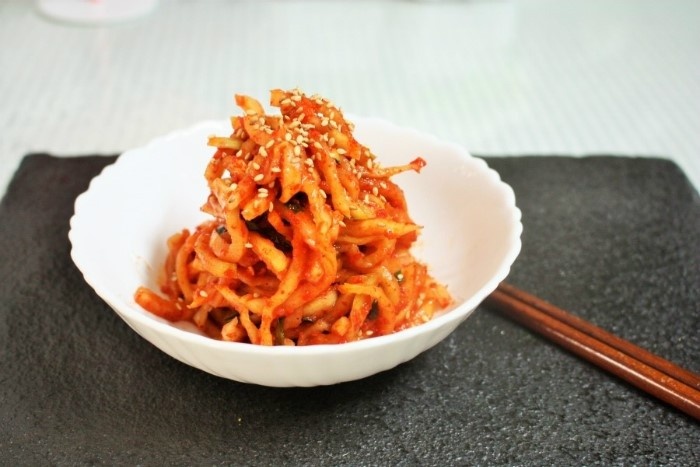Crispy Autumn Radish Salad (Musaengchae)
How to Make Delicious, Crunchy Autumn Radish Salad with Seasonal Fall Radishes

As the weather turns chilly, a spicy and refreshing dish like Musaengchae comes to mind! This crisp radish salad, made with fresh fall radishes and turnip I brought from Ganghwa, is a true rice thief – so good you won’t need other side dishes. The delightful crunchy texture and the perfectly balanced sweet and sour spicy dressing are simply divine. Today, I’ll share my detailed recipe for this crowd-pleasing radish salad that your whole family will love.
Ingredients- 4 medium radishes
- 1 onion
- 50g Korean chives
- 3 stalks of green onion (white parts mainly)
Seasoning- 1/2 cup anchovy sauce (bendaengi jeot)
- 3 cloves garlic (minced)
- 1/2 cup minced garlic
- 2 cups gochugaru (Korean chili flakes)
- 1 cup fish sauce (anchovy or shrimp)
- 1/2 cup salted shrimp (saeujeot)
- 1/3 cup plum extract (maesilcheong)
- 1/2 cup salt (for salting the radish)
- 1/2 cup anchovy sauce (bendaengi jeot)
- 3 cloves garlic (minced)
- 1/2 cup minced garlic
- 2 cups gochugaru (Korean chili flakes)
- 1 cup fish sauce (anchovy or shrimp)
- 1/2 cup salted shrimp (saeujeot)
- 1/3 cup plum extract (maesilcheong)
- 1/2 cup salt (for salting the radish)
Cooking Instructions
Step 1
First, wash the fresh fall radishes thoroughly. Using a mandoline slicer or a julienne peeler makes it easy to cut the radishes into uniform, thin strips, which helps them absorb the seasoning better. While some traditionalists prefer hand-cut radishes, modern peelers are efficient and allow for consistent results. You can adjust the thickness of the julienned radish to your preference – thicker cuts will yield a crisper texture, while thinner cuts will absorb the seasoning more readily.

Step 2
Now, let’s prepare the flavorful seasoning paste. Bendaengi jeot (fermented anchovies) is a key ingredient here, adding a deep umami flavor that elevates the salad. In a blender, combine the bendaengi jeot, minced ginger, onion, minced garlic, and fish sauce. Blend until smooth to create a rich seasoning paste. Making a generous batch is practical, as this paste can also be used for making turnip kimchi or other kimchi variations. Prepare the green onions and chives by washing and cutting them into appropriate lengths. Having the seasoning paste ready and slightly fermented beforehand allows for an even deeper flavor.

Step 3
Sprinkle a little salt over the julienned radishes and let them sit for about 10-15 minutes to lightly salt them. Salting the radish beforehand is crucial; it draws out some moisture, making the radish tender and allowing it to absorb the seasoning beautifully. If you were to mix the raw radish directly, it might remain too stiff and the seasoning wouldn’t penetrate well. After lightly salting, gently squeeze out any excess water. Then, add the prepared seasoning paste to the radish strips and gently mix everything together. Be careful not to overmix or mash the radish; gentle tossing is key to maintaining its crispness.

Step 4
Once the chili flakes have evenly coated the radish, add the chopped green onions and chives. Gently toss again to combine. The fresh aroma of the onions and chives will further enhance the salad’s flavor profile. Taste the salad at this stage and adjust the seasoning if necessary, adding a bit more salt or fish sauce if needed.

Step 5
After making a large batch, set aside a portion for immediate enjoyment. The freshly mixed Musaengchae is wonderfully crunchy and has a satisfying chewy texture. If you plan to eat it right away, a drizzle of sesame oil and a sprinkle of toasted sesame seeds will add a delightful nutty finish. For those who prefer a touch of sweetness, you can add a tiny bit of sugar, but the natural sweetness of the radish and the plum extract usually suffice. I found it perfectly delicious without added sugar.

Step 6
This delicious radish salad is so good, it can easily make you eat an extra bowl or two of rice! Mix it generously into your warm rice for a simple yet incredibly satisfying meal. It’s quite different from the Musaengchae typically made for large kimchi preparations, which often includes glutinous rice paste and more fish sauce. This version is perfect for enjoying on its own.

Step 7
Everyone knows that fall radishes are not only delicious but also great for digestion and packed with nutrients! Making a generous batch of this tasty radish salad before the main kimchi-making season means you can enjoy a hearty and flavorful meal without needing many other side dishes. Embrace the freshness of the season and enjoy this wonderful recipe!

Step 8
As a bonus, the turnip kimchi we made alongside this is also fermenting beautifully! I’ll be sharing the recipe for that delicious turnip kimchi soon, so stay tuned!




